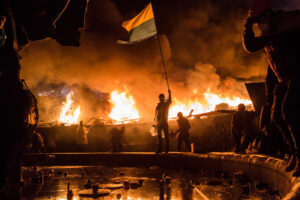In his State of the Union speech last month, President Joe Biden told America that, while he strongly supports Ukraine against Russia’s aggression, he won’t have US troops deployed in Ukraine. “Killing Russians”, he has previously made clear, is a strict red line. Less clear, however, is what Biden thinks the US should do instead. Would, for instance, Biden agree to Americans shooting down the missiles and drones that, every month, kill hundreds of Ukrainian civilians in cities far from the front lines? On Sunday, as Eastern Europe braced itself for the fall-out from a terror attack in Moscow, one of these missiles briefly crossed through Polish airspace. How long can the West allow this to happen, risking further escalation that may include weapons of mass destruction?
Since the first day of Putin’s war, the Russian military has conducted two separate but coordinated operations: a ground campaign intended to seize terrain, and an air campaign intended to disrupt Ukrainian logistics and terrorise the population. This is why, as Western nations rallied to support Ukraine with weapons, ammunition and funding, some observers suggested that the West should establish a “no-fly” zone over Ukraine to protect cities and infrastructure from Russian air attacks. Ultimately, the idea was rejected by Western leaders, who understandably erred on the side of caution, not knowing then how many Russian and Ukrainian lives would be at risk or how long the war would last. In hindsight, it was a deadly decision. Russia’s ensuing campaign of air attacks by missiles, drones, and bombs is now a recognised war crime which, according to the UN, kills an average of 500 to 1,000 civilians a month.
Today, everyone has a much better understanding of the outlines of Putin’s war. As Russian military analyst Ruslan Pukhov recently wrote, Russia (and others) initially thought that its “special military operation” would be more of a “special” than “military” operation, and assumed that it could be completed without large-scale military operations or organised military resistance. But now it’s clear that the ground campaign is “doomed”, with “a protracted war” in the style of the Korean or Iran-Iraq wars seemingly inevitable. This means that, while fighting along the front lines will likely stall, Russia’s air campaign could continue unabated for years to come. In fact, we know that it escalated in the first months of 2024.
More importantly, in terms of defence, we also know that, while Russia flies manned aircraft in battles along the front lines, it does not send manned aircraft deep into Ukraine to bomb cities or infrastructure: such attacks early in the war proved too costly for pilots and airframes. Two years later, this means that air-defence systems deployed around major cities deep in Ukrainian territory do not risk killing Russian pilots or troops. Indeed, since the outbreak of the war, the West has already donated a number of air-defence systems to Ukraine, some of which are protecting cities and infrastructure.
But today, what Ukraine lacks as much as the systems are the soldiers to operate them. To help with this, Western countries — which are running short on “spare” air defence systems — could deploy them to Ukraine, but keep them in the hands of the troops that man them.
Of course, this approach carries obvious risks, depending on the nature of Russia’s response. Putin and his leadership circle have frequently reminded the West that, should they intervene more explicitly in the conflict, Russia might resort to nuclear weapons in Ukraine. To that end, Putin has deployed nuclear-capable Iskander surface-to-surface missile units in Crimea and Belarus, the latter of which also contains Russian tactical warheads. Moscow also retains the capability to launch nuclear cruise missiles from deep inside the territory of the Russian Federation. It’s not unreasonable to imagine that Western air-defence units could provoke a nuclear attack in Ukraine — one of the things they are meant to protect against.
For now, the West has hedged against this risk by avoiding any full deployment of troop units into Ukraine. Indeed, when French President Emmanuel Macron said in February that the possibility of Western troops in Ukraine should not be excluded, Putin responded with more nuclear sabre-rattling, saying that, although he didn’t see a reason to use nuclear weapons in Ukraine at this time, “from a military-technical point of view, we are, of course, ready”. And yet, the uncomfortable reality is that we are at an inflection point in this war — one where, in choosing whether to deploy air-defence units to Ukraine’s vulnerable cities, we should be influenced not so much by the hunch that Putin won’t use a nuclear weapon, but by the realisation that he might. And if he does, it would be a travesty if the West had not done all it could to help Ukraine defend itself.
There are several ways that the West could do this. The least provocative scenario, and one sure to avoid killing Russians, would be to take on the mission of protecting some of Ukraine’s key cities in the western half of the country, far from the front lines. All of the five largest cities still under the control of Ukraine — Kyiv, Lviv, Odesa, Dnipro and Kharkiv — are attacked regularly by Russian missiles and drones. Of these, Western nations could take on the mission of helping to defend Kyiv, Lviv and Odesa, which lie on or west of the Dnieper River that divides the country running north to south. Meanwhile, Dnipro and Kharkiv, which lie farther east, closer to the front lines, would remain under the sole protection of Ukrainian air defences.
What would the new defences look like? The main threats to Kyiv, Lviv and Odesa are ballistic and cruise missiles, as well as long-range drones, which could be countered through a combination of long-range anti-missile systems, such as the US-built Patriot or Russian-built S300/400. Two battalions would provide good coverage for the main parts of a large city, while also being able to intercept and destroy the sorts of missiles that carry tactical nuclear weapons.
Crucially, a dozen countries in Europe use some combination of these defence systems, while America boasts roughly 15 Patriot battalions alone. The US could also volunteer its THAAD installations (Terminal High Altitude Area Defense), which have the added benefit of defending several targets over a wide area, and which are especially designed to protect against ballistic and cruise missiles. Finally, as part of America’s European Phased Adaptive Approach (EPAA), there are fixed-site, American-operated Aegis Ashore interceptors stationed in Deveselu, Romania, soon to be joined by an installation in Redzikowo, Poland. These sites, integrated with US Navy ships, protect against ballistic missile threats from outside the Euro-Atlantic area, and could cover Ukraine too.
But how likely is it that these will be deployed? To date, the EU and Nato continue to rule out sending troops, though some individual members are following Macron’s lead. Estonian Prime Minister Kaja Kallas, who reportedly would like to be the next Secretary General of Nato, recently said “everything” must be on the table to help Ukraine beat Russia, while Lithuania and Poland’s respective foreign ministers voiced their agreement. Such rhetoric shouldn’t be underestimated: since Putin’s invasion, America and the West have looked to the Baltic states to take the lead — whether on the introduction of armoured vehicles, tanks, long-range artillery or aircraft. Only once a new plateau of aid was broached by these countries did the US use the precedent to become a leader in its quantity and quality. The same will be true for any deployment of troops into Ukraine.
This doesn’t mean that there won’t be impediments. Looking ahead, the presence of Western troops in Ukraine could complicate negotiations when this war nears its end. When, for instance, should they leave? And, more importantly, what will they leave behind? But this insecurity will be worth it if it gives the West a seat at the table when that time comes. We have an interest in the outcome of the war, and having troops on the ground provides leverage that we otherwise would not have. Russia understands this strategy very well. Moscow sent aviators to fight in Korea and air defences and advisors to Vietnam, and it later deployed troops to the Balkans and Syria to steer the outcome of those conflicts.
But more straightforwardly, it’s not too hard to imagine the West deploying air-defence units to protect Ukrainian cities and infrastructure today. We did it before in Iraq, Libya and the Balkans, and, as Macron reminded us, “many of those who are saying ‘never, never’ today are the same ones who said ‘never tanks, never planes, never long-range missiles’ two years ago”. If the West had acted then with air defences, it would have saved thousands of lives. If it acts now, it might save millions.
Disclaimer
Some of the posts we share are controversial and we do not necessarily agree with them in the whole extend. Sometimes we agree with the content or part of it but we do not agree with the narration or language. Nevertheless we find them somehow interesting, valuable and/or informative or we share them, because we strongly believe in freedom of speech, free press and journalism. We strongly encourage you to have a critical approach to all the content, do your own research and analysis to build your own opinion.
We would be glad to have your feedback.
Source: UnHerd Read the original article here: https://unherd.com/



